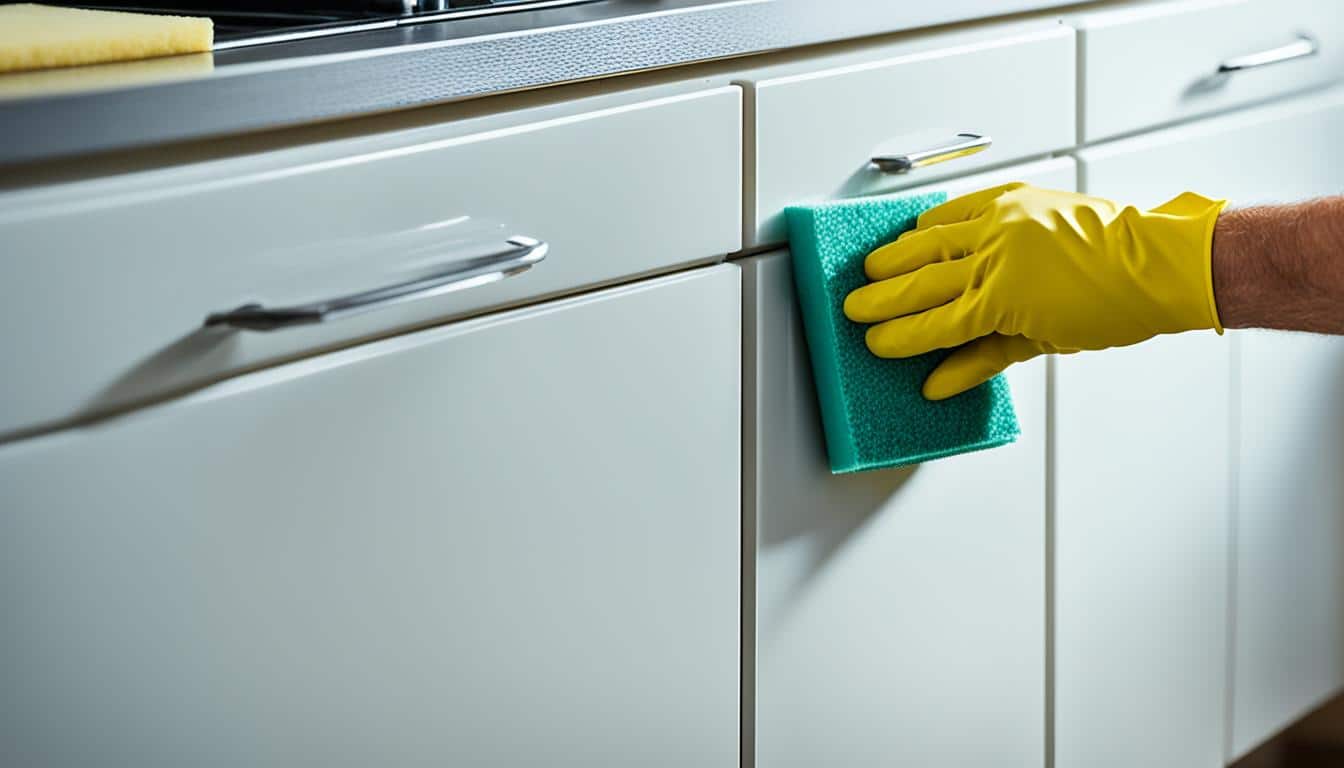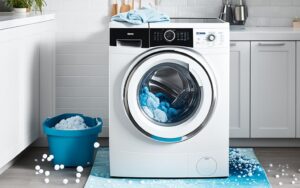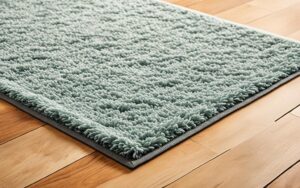Did you know that grease buildup on kitchen cabinets is a common issue faced by 70% of homeowners?
Not only does this grease make your cabinets look dirty and unappealing, but it can also deteriorate the quality of the wood and lead to costly repairs.
That’s why it’s crucial to protect your kitchen cabinets from grease and prevent buildup.
In this article, I will share the best ways to safeguard your cabinets from grease and provide you with easy steps and tips for a grease-resistant and pristine kitchen environment.
How to Clean Kitchen Cabinet Grease: Step-by-Step Guide.
Cleaning kitchen cabinet grease is essential to keep your cabinets looking spotless. Follow this step-by-step guide to effectively remove grease from your cabinets:
1. Declutter and Prepare
Start by emptying the cabinets and drawers to declutter and make the cleaning process easier. This allows you to access all the surfaces and corners of your cabinets.
2. Dish Soap and Warm Water
Mix dish soap with warm water and use a microfiber cloth to wipe down the greasy surfaces of your cabinets. The combination of dish soap and warm water will help break down the grease and remove it effectively.
3. Tackle Stubborn Grease Stains
If you encounter stubborn grease stains, mix equal parts white vinegar and water in a spray bottle. Spray this mixture onto the greasy spots and use a cloth to wipe away the grease.
White vinegar is an excellent natural degreaser that helps dissolve and lift stubborn grease stains.
4. Baking Soda Scrub
Create a paste by mixing baking soda with water. Apply the paste to the grease spots on your cabinets and scrub gently with an old toothbrush.
Baking soda acts as an abrasive, assisting in lifting tough grease stains. Rinse the cabinets with water to remove any residue.
5. Clean Cabinet Handles and Knobs
Don’t forget to clean your cabinet handles and knobs! Soak them in warm, soapy water or use a cloth soaked in the dish soap or vinegar mixture to wipe them clean.
Pay attention to the corners and crevices to ensure a thorough clean.
6. Use Cabinet Liners for Easy Maintenance
To prevent future grease buildup, consider using cabinet liners. These liners can be easily inserted into your cabinets and are removable for easy cleaning.
They act as a barrier between the cabinets and any spills or grease, making regular maintenance quick and easy.
7. Lemon Juice Booster
For green cleaning enthusiasts, lemon juice can be mixed with baking soda to create a powerful grease-cutting solution. Apply the paste to stubborn grease stains, let it sit for a few minutes, and then scrub gently.
The acidity in lemon juice helps break down the grease, leaving your cabinets clean and fresh.
8. Wipe Down with Damp Cloth
Finish by wiping down your cabinets with a clean, damp cloth to remove any residue and ensure a sparkling finish. This final step helps remove any remaining cleaning solution and leaves your cabinets looking clean and grease-free.
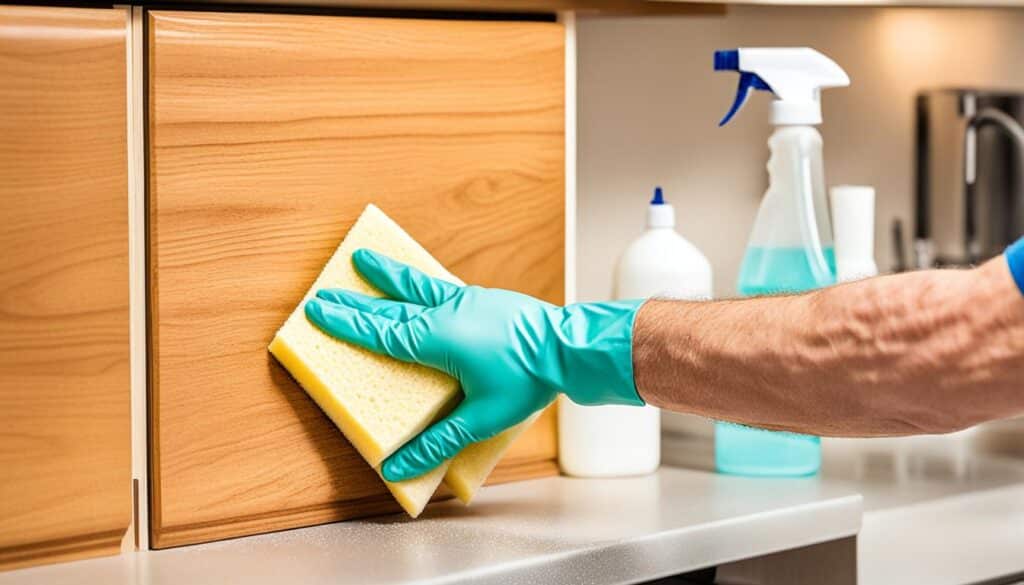
Following these step-by-step instructions will help you effectively clean kitchen cabinet grease and keep your cabinets looking their best.
Regular maintenance and preventive measures, such as using cabinet liners, will ensure that your cabinets remain clean and grease-free for years to come.
Protecting Kitchen Cabinets with Sealants and Top Coats.
To ensure the longevity, durability, and aesthetic appeal of your kitchen cabinets, it is crucial to implement proper protection measures.
Applying a suitable cabinet protective top coat or sealant can safeguard your cabinets from various elements, including grease.
There are different types of clear coats available, such as polyurethane, wax, varnish, and lacquer, each offering unique advantages.
When selecting a sealant, you have the option to choose between a glossy or matte finish, depending on your personal preference and the overall look you want to achieve in your kitchen.
A glossy finish provides a sleek and polished appearance, while a matte finish exudes a natural and understated charm.
The process of sealing kitchen cabinets involves several steps. Firstly, proper surface preparation is essential for ensuring the sealant adheres well to the cabinets.
This may include cleaning, sanding, and removing any existing finishes. Then, carefully select the appropriate sealant based on your cabinet material and desired outcome.
Apply the sealant using recommended techniques, such as brushing or spraying, and follow the manufacturer’s instructions regarding drying times and any additional coats required.
Waxing can also serve as a viable option for protecting kitchen cabinets. Applying a layer of wax on top of the sealant can provide an extra level of defense against grease and other potential stains.
Additionally, waxing enhances the cabinet’s appearance by giving it a lustrous sheen.
It is important to consider the material of your cabinets when choosing a sealant. Pressed wood, particle board, and plywood cabinets may require specific products or techniques to ensure proper protection.
By properly sealing your kitchen cabinets, you create a barrier that defends against grease, moisture, and other common kitchen hazards.
This not only helps maintain the pristine condition of your cabinets but also contributes to their overall durability and longevity.
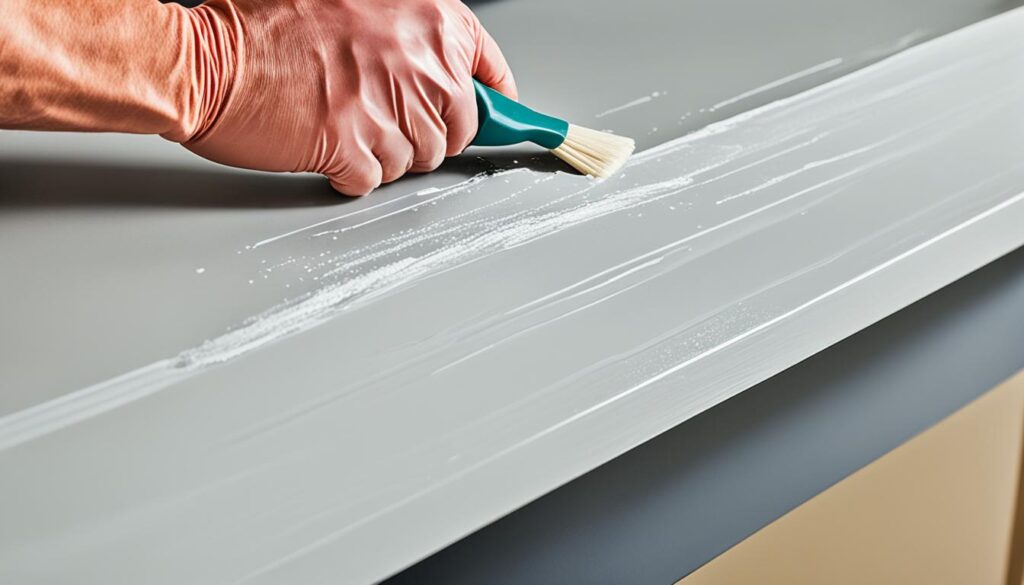
Removing Grease from Kitchen Cabinets: Expert Techniques.
Regularly removing grease from your kitchen cabinets is essential for maintaining cleanliness and preventing the buildup of bacteria and other harmful microorganisms.
To effectively remove grease and achieve clean and grease-free cabinets, you can follow these expert techniques:
- Use dish soap and warm water: Combine a few drops of dish soap with warm water in a bucket or sink. Dip a microfiber cloth or sponge into the soapy solution and gently scrub the greasy areas of your cabinets. Rinse the cloth or sponge frequently and continue until the grease is removed.
- Utilize natural degreasers: Opt for citrus-based multipurpose cleaners that contain natural oils. These cleaners are highly effective in cutting through grease. Spray the cleaner onto the greasy spots, let it sit for a few minutes, and then wipe it away with a damp cloth.
- Try vinegar and hot water: Mix equal parts white vinegar and hot water in a spray bottle. Spray the solution onto the greasy surfaces and let it sit for a few minutes. Wipe clean with a microfiber cloth or sponge. Vinegar’s acidic properties help dissolve the grease, making it easier to remove.
- Create a baking soda and lemon juice paste: Mix baking soda and lemon juice to create a thick paste. Apply the paste to the greasy areas and let it sit for a few minutes. Scrub gently with a sponge or cloth, and then rinse with warm water. Baking soda acts as an abrasive agent, while lemon juice acts as a natural degreaser, helping to eliminate stubborn grease buildup.
Remember to take safety precautions, such as wearing protective gloves, when using cleaning products. Proper ventilation is also important to ensure a safe cleaning environment.
In addition to these degreasing techniques, it is crucial to implement preventive measures and regularly maintain your cabinets.
Consider applying protective coatings, such as wax or sealants, to create a barrier against grease and make future cleaning easier. For wood cabinets, follow specific care instructions to avoid damage.
By following these tips and techniques, you can achieve clean and grease-free kitchen cabinets that not only look great but also promote a healthy and hygienic kitchen environment.
FAQ
How Can I Protect My Kitchen Cabinets From Grease Buildup?
To protect your kitchen cabinets from grease, you can implement various methods such as regular cleaning with dish soap and warm water, using vinegar or lemon juice for natural grease-busting, utilizing baking soda for stubborn grease stains, and considering protective measures like cabinet liners.
What Is The Best Way To Clean Kitchen Cabinet Grease?
To effectively remove grease from your kitchen cabinets, you can follow this step-by-step guide: empty the cabinets and drawers, mix dish soap with warm water and wipe down the surfaces with a microfiber cloth, use vinegar-water spray for stubborn stains.
Apply a baking soda paste for grease spots, soak and clean cabinet handles and knobs, consider using cabinet liners, and wipe down cabinets with a damp cloth regularly.
How Can I Protect My Kitchen Cabinets With Sealants And Top Coats?
To protect your kitchen cabinets, you can apply a proper cabinet protective top coat or sealant. Options include polyurethane, wax, varnish, and lacquer, each offering unique advantages and finishes.
The process involves surface preparation, sealant selection, application techniques, and drying times. Waxing can also provide an extra layer of protection and enhance the cabinet’s appearance.
What Are Expert Techniques For Removing Grease From Kitchen Cabinets?
Expert techniques for removing grease from kitchen cabinets include using dish soap and warm water with a microfiber cloth or sponge, citrus-based multipurpose cleaners for degreasing, vinegar and hot water for stubborn grease, creating a baking soda and lemon juice paste for aggressive grease removal.
Safety precautions such as wearing protective gloves and ensuring proper ventilation should be taken when using cleaning products.
Regular maintenance, protective coatings like wax or sealants, and considerations for different cabinet materials can help prevent grease buildup and maintain a clean and grease-free kitchen environment.
